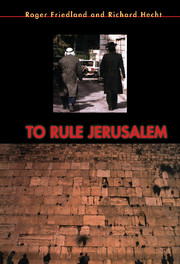Book contents
- Frontmatter
- Contents
- List of Illustrations
- Preface
- Acknowledgments
- Introduction
- 1 A Fearful Fusion
- Part I The Two Zions: Jews Against Zionism in Jerusalem
- Part II Zion Divine: Jerusalem as the Messianic Central City
- Part III Birth of a Nation
- Part IV Heart of Stone
- 16 Al-Quds and Tunis
- 17 The City That Ate Palestine
- 18 Heart of Stone
- Notes
- Index
18 - Heart of Stone
Published online by Cambridge University Press: 13 May 2010
- Frontmatter
- Contents
- List of Illustrations
- Preface
- Acknowledgments
- Introduction
- 1 A Fearful Fusion
- Part I The Two Zions: Jews Against Zionism in Jerusalem
- Part II Zion Divine: Jerusalem as the Messianic Central City
- Part III Birth of a Nation
- Part IV Heart of Stone
- 16 Al-Quds and Tunis
- 17 The City That Ate Palestine
- 18 Heart of Stone
- Notes
- Index
Summary
It began with knives and a swelling pool of blood. On the verge of an apparent peace Israelis were being stabbed to death by Palestinians who enfold seedlings in the earth of Israel, scrub pots in its kitchens, and spread mortar in its new suburbs. On March 31, 1993, Israel closed the arteries linking Palestinians of the West Bank and Gaza to its sovereign body – a closing out, not in. The closure of Israel to almost all Palestinians from outside became a permanent feature of the landscape. Hundreds of thousands of Palestinians who used to work or shop in Jerusalem were forbidden to cross into Zion from the West Bank. Although a few thousand had their jobs taken by new Russian immigrants desperate for employment, about fifty thousand Arabs – mostly construction and agricultural workers – were eventually given permission to go in and out of Israel each day, a fragile privilege that could be revoked at any moment.
It is December 1993 and the hopoe birds, feathered in funereal shades, scavenge in twos and threes in the Jerusalem hills. Rabin and Arafat are bickering over the implementation of the Declaration of Principles, and still Jerusalem is forbidden to most Palestinians, closed to all but the very old and the very young. A couple of Palestinian flags hang limply over the major hotels in the Arab downtown. A furniture store sells a big office chair, its leather carefully ruled into red, green, black, and white. The boisterous waving, the explosive display, of longforbidden Palestinian colors is over.
- Type
- Chapter
- Information
- To Rule Jerusalem , pp. 464 - 490Publisher: Cambridge University PressPrint publication year: 1996

